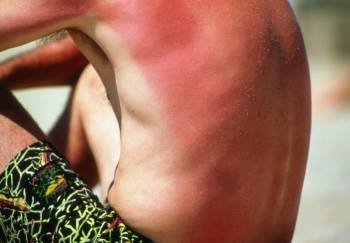Written by Dr. Pradeep
Sunburn
What is sunburn?

Sunburn is painful reddening of your skin caused by the UV (ultraviolet) rays in sunlight.
-
-
- Although sunburn is usually worse on exposed skin, you can get sunburn in areas covered by clothes
- You can get sunburn even on a cloudy day, because clouds don’t block UV rays
- If a sunburn is severe, you may have fever or chills and blisters on your sunburned skin
- To ease the pain of a sunburn, use lotions, take pain medicine, and put a cool wet cloth on your skin
- To lower the chance of a sunburn, use sunscreen and avoid going out when the sun is strongest
-
The UV light used in tanning lamps and tanning beds can also cause painful skin reddening and skin damage.
What causes sunburn?
Sunburn is caused by the UV (ultraviolet) rays in sunlight. You’re most likely to get sunburn in the middle of the day (10 AM to 3 PM) because that’s when UV rays are strongest.
The risk of sunburn is higher in people who:
-
-
- Have light skin, blue eyes, and blond or red hair
- Work outdoors
- Have had sunburn before
-
Because tanning beds use UV light to give you a tan, you can also get a burn from staying too long in a tanning bed.
What are the symptoms of sunburn?
Symptoms may start an hour after you get burned. They’re usually worst in the 12 to 24 hours after you get burned. You’ll have:
-
-
- Painful, red skin
- Sometimes blisters
- Fever, chills, and weakness if your burn is severe
-
A few days later, the burn will itch and the outer layer of skin will flake off.
Sometimes, sunburned skin gets infected.
If you had a bad sunburn when you were young, you have a higher chance of getting melanoma (a type of skin cancer) when you’re older.
How do doctors treat sunburn?
To lessen the pain of a milder sunburn, doctors will tell you to:
-
- Take over-the-counter pain medicine such as ibuprofen
- Take a cool shower or bath
- Put a cool wet cloth, petroleum jelly, aloe, or moisturizing lotion (one with no perfume) on your sunburn
Some sunburn sprays and lotions contain a numbing medicine that takes the pain away for a little while. Doctors usually say you shouldn’t use these because many people develop an allergic reaction to the numbing medicine.
To treat severe sunburn, doctors may:
- Give you an antibiotic cream to put on your blisters
Don’t pop your blisters. Keep your sunburned skin out of the sunlight for several weeks, especially if it’s peeling. The new skin underneath is very thin and sensitive.
How do I prevent sunburn?
The best way to prevent sunburn is to stay out of the sun. There’s a higher chance of getting sunburn:
-
- Between 10 AM and 3 PM (when UV rays are strongest)
- At high altitudes, such as in the mountains
- When sunlight is reflected off snow, water, or sand
When you have to go out in the sun:
-
- Stay out no longer than 30 minutes
- Wear a wide-brimmed hat and clothing that protects you—such as special clothing made with sun protection
- Wear sunglasses
- Use sunscreen
Tips for using sunscreen:
-
- Choose a water-resistant sunscreen with an SPF (sun protection factor) of 30 or more
- Use sunscreen that protects against both types of UV rays (UVA and UVB)
- Apply an ounce of sunscreen (the amount needed to fill a shot glass) to cover your body—most people don’t use enough
- Apply it 30 minutes before you go out into strong direct sunlight and reapply it every 2 hours or after you sweat or swim
- For small areas such as your nose or lips, consider also applying a sunblock (sunblock is a thick, white cream that contains zinc and titanium) that physically blocks almost all sunlight from your skin
Related Procedures

Leg Hair Removal

Loyalty Rewards

Body Hair Removal

Facial Hair Removal

For Dark Skin

Threading

Alexandrite Laser

Electrolysis

